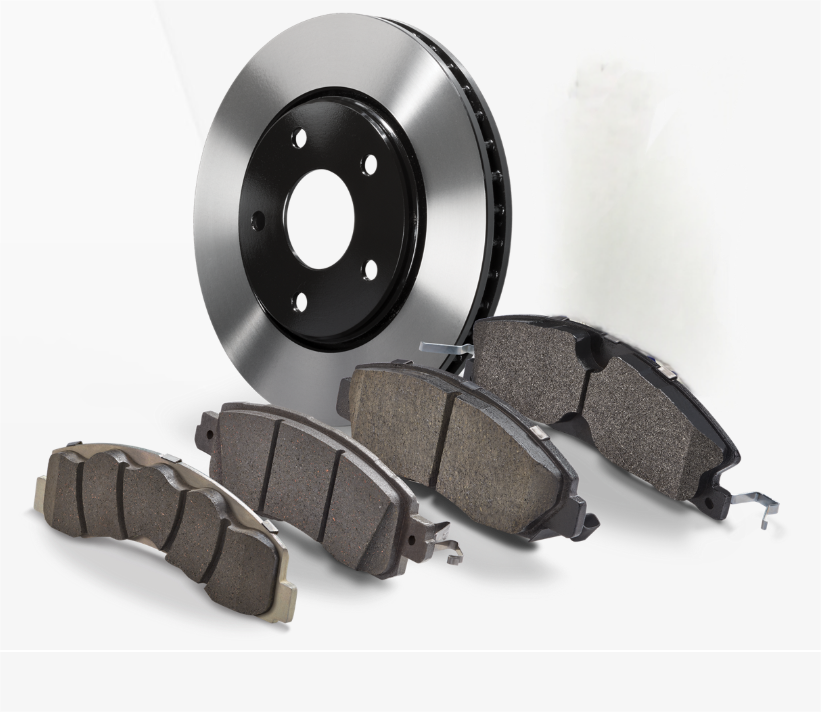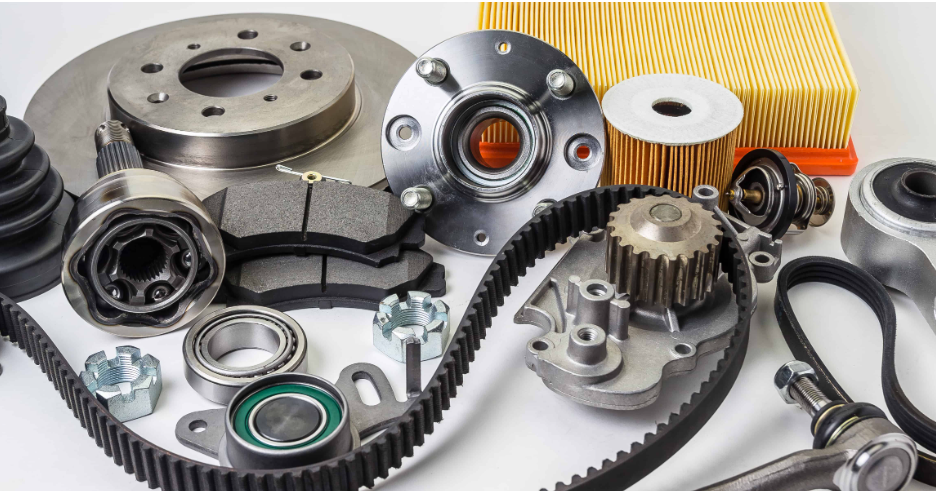Understanding Brake Pad Materials and Types
Organic Brake Pads: Quiet Performance for Light Use
Organic brake pads, consisting of rubber, carbon compounds, and resins, are crafted for quiet and smooth braking performance. These pads are particularly well-suited for light-duty vehicles and those frequently used in urban commuting due to their minimal noise and cost-effectiveness. Although the lower cost and lighter weight can enhance fuel efficiency, one drawback is their relatively quick wear in high-stress conditions. This factor makes them less ideal for high-performance vehicles or heavy-duty applications. However, their affordability and the quiet operation make them a popular choice for daily drivers.
Semi-Metallic Brake Pads: Durability for Heavy-Duty Needs
Semi-metallic brake pads are designed with metal fibers that provide superior durability and outstanding heat dissipation. This construction makes them an excellent choice for heavy-duty vehicles, such as trucks, that require enhanced braking performance under demanding conditions. These pads offer enhanced stopping power compared to organic pads, even at varying temperatures and road conditions. Despite their durability, they are known to be noisier and can produce more brake dust, making them suitable primarily for industrial or demanding environments where noise is less of a concern. Statistical data suggests their preference in strenuous driving scenarios.
Ceramic Brake Pads: Low Dust and Longevity
Ceramic brake pads are favored for their construction from dense ceramic materials that ensure low dust emission and quieter operation. These pads outperform their organic and semi-metallic counterparts in lifespan, effectively enduring higher temperatures without sacrificing performance. Everyday drivers increasingly prefer ceramic pads due to their durability and the minimal maintenance they require. Their ability to handle high brake temperatures makes them an ideal choice for urban and highway driving, though they come at a higher cost. Research shows a growing trend towards ceramic pads, especially for those seeking a balance of performance and maintenance in regular driving conditions.
High-Performance Brake Pads: Track-Ready Solutions
High-performance brake pads are engineered for extreme conditions, delivering exceptional stopping power for sports cars and racing applications. They are built to withstand the intense heat generated by heavy braking during motorsport events or high-speed driving. While these pads might produce more noise and dust, their superior braking capabilities make them indispensable for automotive enthusiasts participating in professional racing or track days. Various expert reviews highlight these pads as a recommended choice for vehicles needing reliable performance under pressure, emphasizing their suitability for enthusiasts demanding maximum efficacy from their automotive brake system parts.
Key Factors in Brake Pad Selection
Driving Habits: Commuting vs. Performance Driving
When selecting brake pads, I need to consider my driving habits. For daily commuting, quieter organic brake pads are often suitable due to their reduced noise levels. Yet, for performance driving or high-speed conditions, high-performance brake pads are a better fit as they provide the added stopping power needed. These pads cater to more spirited driving styles by offering greater friction. Research confirms that aggressive driving styles can expedite brake pad wear, necessitating more frequent replacements, especially if using softer pads. Therefore, recognizing my driving habits can significantly impact my brake pad choice and how often I plan to change them.
Vehicle Weight and Towing Requirements
For those of us driving heavier vehicles or frequently towing loads, it's crucial to choose brake pads that can handle the stress. Options like semi-metallic or high-performance brake pads are often preferred for their robustness and efficiency in managing the strain of additional weight. There's a well-documented link between vehicle weight and the accelerated wear of standard brake pads, causing heavier vehicles to require part replacements more frequently. Hence, if my vehicle or driving activities involve extra weight, opting for a more durable brake pad is essential to ensure adequate braking performance and longevity.
Climate: Heat Resistance and Cold Weather Performance
Considering climate is fundamental when selecting brake pads, as their performance can vary greatly with weather conditions. Semi-metallic pads are known for excelling in high temperatures, making them ideal for hot climates. However, organic brake pads might not perform as well in cold weather conditions. Studies highlight that brake pads' functionality can markedly diminish during frigid temperatures, so it’s crucial to factor in local weather when making a pad selection. By aligning brake pad material with the prevailing climate, I can ensure optimal performance and safety throughout varying seasonal changes.
Vehicle-Specific Brake Pad Considerations
Best Brake Pads for Trucks and SUVs
When selecting brake pads for trucks and SUVs, it's crucial to consider the additional weight and towing capacity these vehicles often possess. Semi-metallic brake pads are typically recommended for their ability to handle heavier loads effectively. These pads are engineered to withstand the increased strain of larger vehicles, ensuring both performance and safety during demanding conditions. They offer superior stopping power and durability, making them an ideal choice for vehicles that frequently tow or carry significant weight. Experts consistently emphasize the importance of choosing brake pads that align with the specific use of the vehicle, thereby optimizing overall vehicle performance and ensuring safety under load.
High-Performance Vehicles: Managing Extreme Heat
High-performance vehicles demand brake pads that are capable of managing the intense heat generated during extreme driving situations. To maintain effective braking and prevent brake fade, which is a significant safety concern, it is vital to use high-performance brake pads. These pads are designed with advanced materials that dissipate heat efficiently, thereby optimizing braking performance in high-temperature conditions. Research and statistics from motorsports analyses have shown how improper pad selection can lead to brake fade, compromising safety at critical times. Choosing the right brake pads for high-performance vehicles is not only about performance enhancement but also about ensuring the safety of both the driver and the vehicle.
Daily Drivers: Balancing Cost and Comfort
For daily drivers, achieving a balance between cost and comfort is essential in brake pad selection. Ceramic brake pads are particularly popular for everyday vehicles as they offer long-lasting durability and minimized noise, catering to the comfort needs of routine drivers. Although they may require a higher initial investment, ceramic pads can save money over time by reducing the frequency of brake pad replacements. As research indicates, opting for quality brake pads can ultimately be more cost-effective due to their prolonged lifespan, translating to fewer replacements and repairs. Hence, for daily commuting, ceramic brake pads represent a practical choice that harmonizes both economic and comfort considerations.
Ensuring Compatibility with Your Brake System
Rotor Size and Caliper Specifications
Matching brake pads with your vehicle's rotor size and caliper specifications is crucial for achieving optimal braking performance and safety. Incompatibility can result in uneven brake pad wear and could potentially compromise braking efficiency, leading to unsafe driving conditions. For instance, studies have highlighted that variations in rotor size can significantly impact stopping distances, underscoring the necessity for accurate measurements when selecting brake pads. Therefore, it's imperative to ensure that your brake pads are precisely compatible with your vehicle's rotor size and caliper specifications for reliable and effective braking.
OEM vs. Aftermarket Fitment Guidelines
Understanding the differences between OEM (Original Equipment Manufacturer) brake pads and aftermarket options is vital for making informed choices. OEM brake pads provide assurance of a specific fit and performance standard, as they are designed to match the original parts of the vehicle precisely. However, aftermarket brake pads offer a broader variety and potential cost savings, accommodating diverse needs and preferences. Despite these advantages, automotive surveys suggest that while aftermarket parts can indeed be beneficial, they might sometimes compromise quality, affecting overall vehicle safety. Thus, it's crucial to weigh these considerations carefully to ensure the right fit for your brake system.
Maintenance and Replacement Best Practices
Signs of Wear: Squealing, Vibrations, and Reduced Stopping Power
It's crucial to be aware of the common signs of brake pad wear, such as squealing noises, vibrations during braking, and reduced stopping power. These indicators are not just nuisances; they are early warning signs that your brake pads may be due for replacement. Ignoring these symptoms can lead to increased risks on the road, making timely recognition essential for safety. According to experts, regular inspections are vital in catching these issues early, promoting better performance and extending the lifespan of brake components.
When to Replace Brake Pads: Mileage and Inspection Tips
Knowing the right time for brake pad replacement can enhance both safety and performance. Generally, it's recommended to replace brake pads between 30,000 to 70,000 miles, though this interval can differ based on the brake pad materials and driving conditions. For instance, the best brake pads for trucks might need different maintenance than those for smaller vehicles. Professional advice emphasizes periodic inspections, which can help gauge wear levels and ensure that braking capabilities are consistently effective. These maintenance tips are vital in avoiding unexpected brake failures.
Extending Lifespan: Proper Bed-In Procedures and Cleaning
Extending the lifespan of brake pads involves more than just timely replacements; proper bed-in procedures can significantly enhance their performance. This process requires gradually applying the brakes after new brake pads are installed to ensure that the brake pad and rotor surfaces properly mate. Additionally, regular cleaning of the brake pads and rotors is essential to prevent debris buildup, which can accelerate wear. Studies suggest that maintaining cleanliness in these automotive brake system parts helps in prolonging component life, thus contributing to both safety and efficiency.







